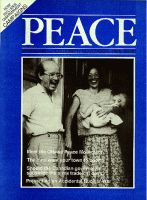
Peace Magazine Oct-Nov 1986, page 45. Some rights reserved.
Search for other articles by Martin Zeilig here
SCATTERED OVER THE FIELDS AND FARMLANDS OF NORTH Dakota, the "Peace Garden State," are 300 intercontinental ballistic missiles, each fitted with 2 or 3 nuclear warheads designed to destroy cities half a world away in the Soviet Union. Many of the missile silos are only a few miles south of the 49th parallel; thus the border separating North Dakota and Manitoba is virtually meaningless, for a nuclear attack on a North Dakota missile field would have devastating consequences for southern Manitoba (indeed for all of Canada).
That's why 3 Winnipeggers joined over 70 Americans for the August 9 and 10 Hiroshima-Nagasaki Memorial Weekend for Peace. The weekend was organized by a coalition of groups from North Dakota and Minnesota and "Nukewatch"-a Wisconsin-based public interest group who have mapped various silo sites throughout the United States, including the one shown here. Camping overnight at a particular was both an emotional and an educational experience. We met committed activists, many of whom have served time in prison for acts of civil disobedience in opposition to the United States government's policies. We met Mark, from Montana, who had served four and a half months in a federal prison work camp in California for a sit-in at a Montana missile silo site. We heard of a mother of seven who along with two other activists had taken a 90-pound jackhammer to a Missouri missile site and destroyed the concrete hatch. (She was represented at the North Dakota event by two of her children, both of whom have Downs syndrome). The three Canadians were encouraged by the resolve and enthusiasm of our American friends. Our neighbors to the south were appreciative of the presence of a small contingent of peace activists from Canada. Further actions will probably be planned in the future at other sites in North Dakota-the world's third nuclear nation.

Peace Magazine Oct-Nov 1986, page 45. Some rights reserved.
Search for other articles by Martin Zeilig here